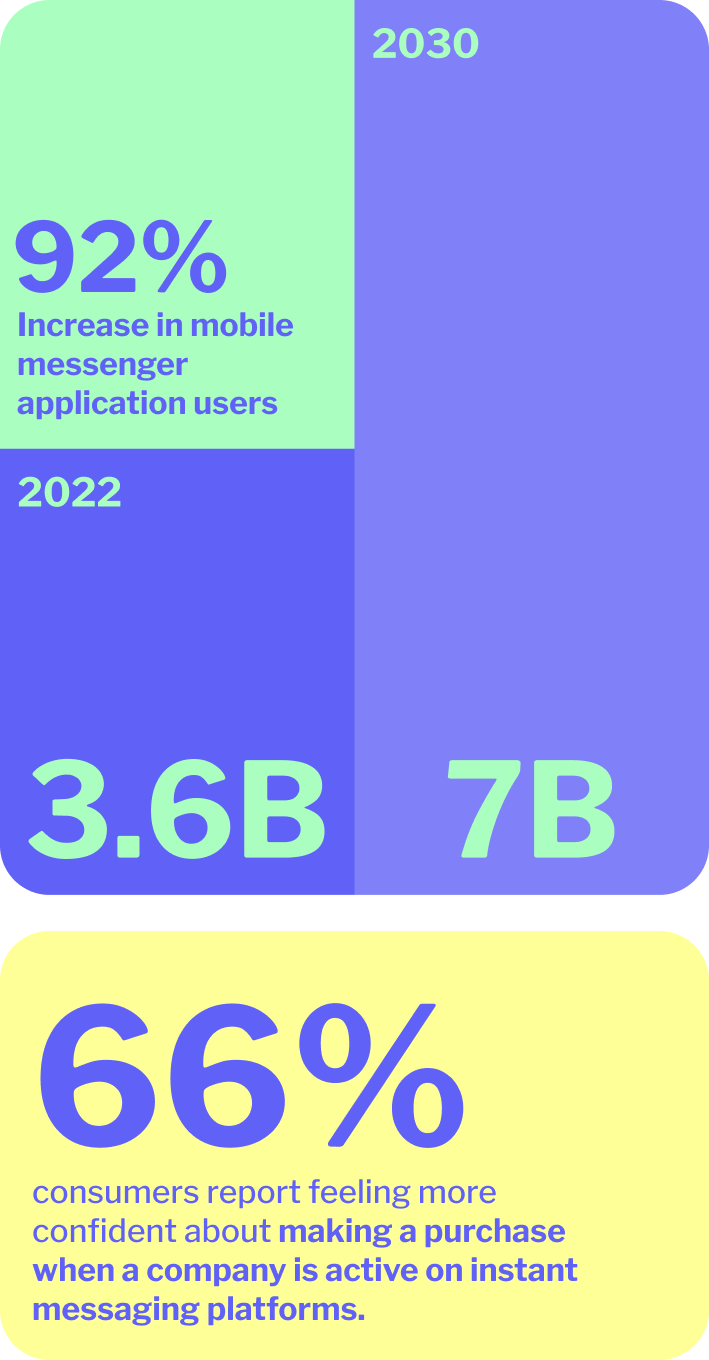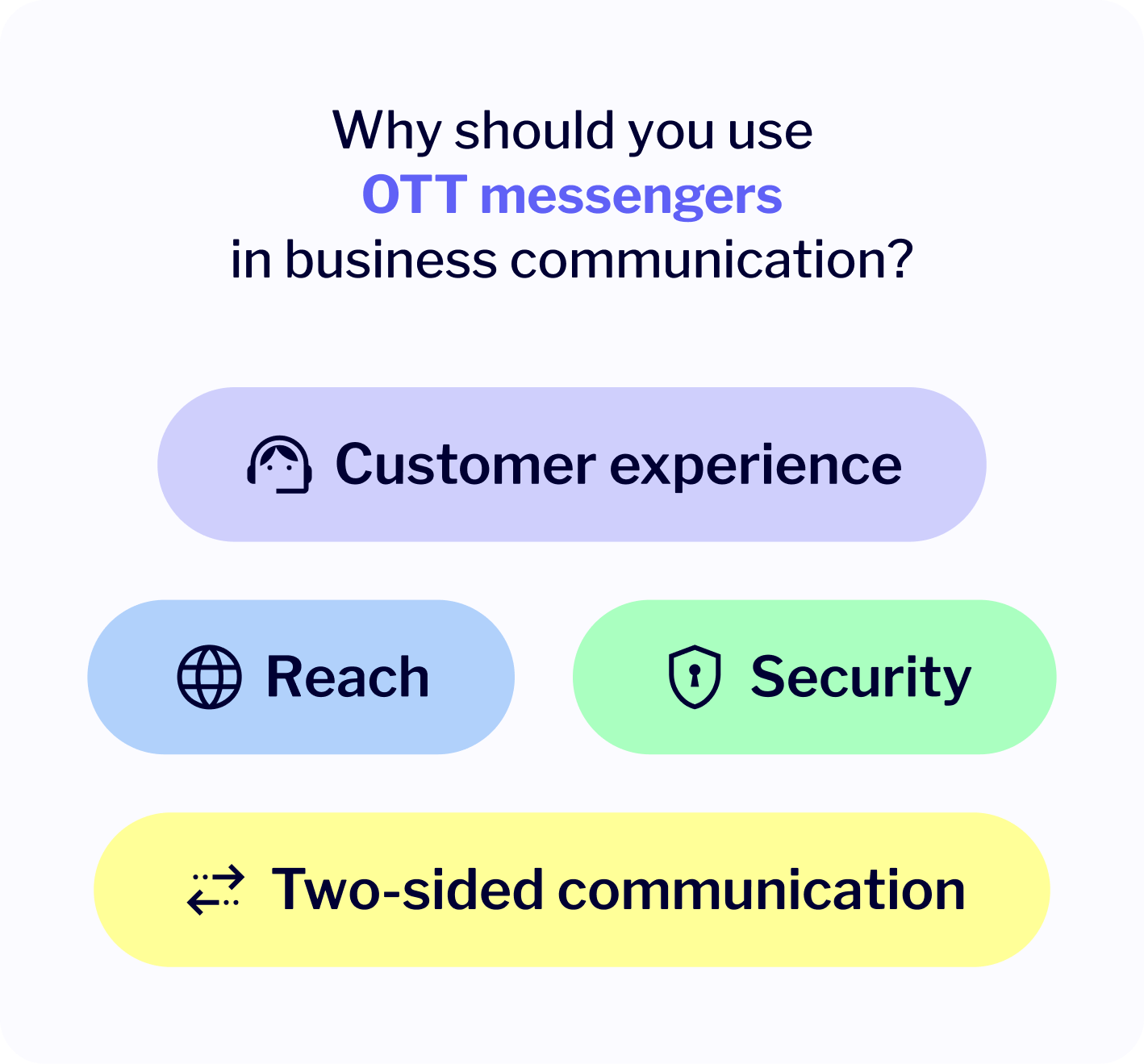Traditional SMS messaging has long been a staple of customer communication, offering a reliable means of delivering information directly to consumers. However, as messaging technologies evolve, over-the-top (OTT) messaging apps like Viber and WhatsApp are gaining significant traction. These platforms offer a wealth of advanced features, a more interactive user experience, and a wider array of communication options compared to SMS.
With that in mind, it should come as no surprise that many businesses choose to expand into OTT messaging applications over continuing to rely solely on SMS. Still, if you’re not convinced, keep reading! In the following article, we will explore the key advantages of OTT messaging. We will examine how these platforms not only enhance customer engagement, but also enable businesses to stay ahead in an increasingly competitive market.
What are OTT messaging platforms?
OTT messaging platforms, or over-the-top messaging applications, are communication tools that operate over the internet, bypassing traditional telecommunications networks like SMS. These are the apps that you likely use every day, such as WhatsApp, Viber, and others. They allow users to send messages, share media, make voice and video calls, and interact in ways far beyond the capabilities of SMS.
The potential of OTT applications is immense, especially as their user bases continue to grow at an unprecedented rate. Mobile messenger application users are projected to reach seven billion globally by 2030. It’s an astounding 92% increase from 3.6 billion users in 2022. What’s more, 66% of consumers report feeling more confident about making a purchase when a company is active on instant messaging platforms.

These numbers demonstrate the vast reach and influence of OTT messaging apps, highlighting the growing importance of these platforms in both personal and business communication. With billions of active users across various regions, these apps provide an unparalleled opportunity to engage with global audiences. As businesses look for more effective ways to connect with consumers, leveraging the power of any OTT messaging channel can open new avenues for growth and customer loyalty.
OTT messaging vs. SMS – What are the main differences between OTT and SMS?
There are quite a few differences between OTT and SMS. OTT messengers offer a more versatile, secure, and cost-effective communication solution compared to SMS, with features that go beyond basic text messaging. However, SMS still holds the advantage of universal accessibility, making it useful in specific contexts where internet access may be limited.
Infrastructure and delivery
SMS operates over traditional cellular networks, relying on mobile carriers to deliver messages. This can result in delays or message failures, especially in areas with weak cellular coverage. In contrast, OTT messaging applications use the internet for message delivery, allowing for faster, more reliable communication in regions with good internet infrastructure.
Multimedia capabilities
SMS is limited to sending text. On the flip side, OTT solutions support a wide range of rich media features, including high-quality images, videos, audio messages, stickers, documents, and even interactive features like payment processing. This versatility enhances user experience and opens new avenues for business communication.
Security and encryption
SMS does not provide end-to-end encryption by default, meaning that messages can be intercepted or accessed by third parties. Most OTT solutions, such as Telegram, offer end-to-end encryption, ensuring that only the sender and recipient can read the messages. Their heightened security is a key advantage for businesses that would like to gain customer trust.
User engagement and features
OTT applications include advanced engagement features such as read receipts, typing indicators, group chats, broadcast lists, and chatbots, which SMS lacks. These features allow for more dynamic, interactive communication and help businesses build and manage customer relationships more effectively.
Reach and accessibility
SMS is universally accessible on all mobile phones, regardless of internet access or smartphone capabilities. Conversely, instant messaging platforms require an internet connection and a smartphone with a specific OTT application installed. This can limit accessibility among users who do not use the said application and in regions with poor internet penetration.
Which OTT applications are most popular?
OTT messaging apps continue to grow in popularity, thanks to their interactive and feature-rich experiences. Each of these platforms caters to specific regional markets and user preferences, offering unique functionalities that go beyond the capabilities of traditional SMS messaging. Here are the most popular OTT messaging solutions out of the bunch!
With over two billion monthly active users as of 2024, WhatsApp is one of the leading OTT messaging platforms worldwide. It supports text, voice, and video messaging, as well as file sharing, group chats, and end-to-end encryption, making it a top choice for both personal and business communication.
Boasting around 1.3 billion active users, WeChat stands as one of the most widely used OTT messaging platforms, especially in China and across Asia. One of WeChat’s standout features is its mini-programs, which are small applications within the platform that allow users to access a variety of services without leaving the application. These include everything from food delivery and e-commerce shopping to booking transportation.
Viber
Viber, with over one billion users, is another popular OTT messaging application known for its ease of use and strong global reach. It supports text, voice, and video calls, along with multimedia sharing and group chats. Viber also offers end-to-end encryption, making it a reliable choice for secure communication.
Facebook Messenger
With around one billion users globally, Facebook Messenger is widely used for both personal and business messages. It offers features like chatbots, multimedia sharing, and integration with Facebook’s broader ecosystem, allowing businesses to reach customers directly.
Telegram
Known for its focus on security and privacy, Telegram has quickly gained popularity, with over 950 million active users. It supports text and multimedia messaging, along with features like secret chats, large group chats, and channels, making it a favourite for users seeking enhanced privacy.
The advantages of using OTT messaging in business communication
Whether it’s offering better customer experiences, reducing costs, or ensuring secure communication, OTT platforms have become essential for businesses aiming to stay competitive. Below are some key reasons why you should consider using OTT messaging for business purposes.
Customer experience
OTT messaging applications provide businesses with the opportunity to deliver a superior customer experience. Unlike traditional SMS, these platforms support rich media, instant responses, and personalised interactions, which make it easier for companies to address customer needs effectively. Features like chatbots, automated replies, and multimedia sharing enable businesses to engage customers with rich content and instant solutions, creating a more interactive and user-friendly experience.
Security
Security remains a top concern for businesses when handling customer data. OTT messaging platforms offer superior security features, including end-to-end encryption, which ensures that only the sender and recipient can access the contents of a message. Such a level of security is critical for businesses dealing with sensitive information, such as financial transactions or personal data. By utilising encrypted messaging applications, companies can provide a safer communication environment for both customers and themselves.
Reach
OTT messaging solutions provide businesses with the ability to target customers across various regions, transcending geographical boundaries that often limit SMS campaigns. The massive user base of these platforms means companies can reach a diverse and widespread customer base, increasing their market presence and improving customer engagement worldwide.
Two-sided communication
Last but not least, OTT applications enable two-sided communication, which is essential for building stronger customer relationships. Unlike one-way messaging through SMS, these platforms allow businesses to engage in dynamic conversations with customers. Customers can easily respond to queries, provide feedback, or ask questions, which helps businesses better understand customer needs. This interactive communication model encourages real-time problem-solving and fosters a sense of connection, allowing businesses to offer more personalised and responsive customer service.

Business use cases for OTT messaging
OTT messaging apps are transforming how businesses communicate with customers by offering instant, direct, and interactive communication channels. Here are a few business use cases where these platforms provide significant value.
Customer support and service
OTT messaging platforms allow businesses to offer seamless customer support. With features like real-time messaging, multimedia sharing, and automated chatbots, businesses can respond quickly to customer inquiries, troubleshoot issues, and provide solutions. This type of communication is faster and more efficient compared to traditional email or phone support, enhancing the overall customer experience.